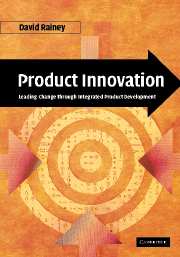Book contents
- Frontmatter
- Contents
- Preface
- Acknowledgements
- Part I Product innovation and strategic logic
- Part II Establishing the foundation: the conceptual level
- Part III Methods and techniques for analysis and decision making
- 7 Product/market considerations, integrated product design, and product architecture
- 8 Marketing strategies and methods: conceptualizing and designing the new-product marketing campaign
- 9 Production strategies and methods: operational and manufacturing implications
- 10 Financial applications and implications
- Part IV The operational level and concluding remarks
- Glossary
- References
- Select bibliography
- Index
9 - Production strategies and methods: operational and manufacturing implications
Published online by Cambridge University Press: 10 August 2009
- Frontmatter
- Contents
- Preface
- Acknowledgements
- Part I Product innovation and strategic logic
- Part II Establishing the foundation: the conceptual level
- Part III Methods and techniques for analysis and decision making
- 7 Product/market considerations, integrated product design, and product architecture
- 8 Marketing strategies and methods: conceptualizing and designing the new-product marketing campaign
- 9 Production strategies and methods: operational and manufacturing implications
- 10 Financial applications and implications
- Part IV The operational level and concluding remarks
- Glossary
- References
- Select bibliography
- Index
Summary
Introduction
Production and supply-chain considerations are essential requirements that must be examined during the conceptual level and turned into definitive approaches during the operational level. The choices are dependent on the new-product development (NPD) situation. While the trend is toward best practices and “world-class manufacturing,” the downstream activities of actually producing the product(s) or providing the service have to be determined through inputs from the entire NPD team as the new-product opportunity makes the transition from concept to commercialization. Once the initial design for a new product is complete, manufacturing capability is typically required to bring the product to market. Whether using in-house manufacturing resources, buying the product entirely from a supplier, or using a combination of these two approaches, the enterprise must produce the new product in larger quantities. Frequently, a product previously made only in small quantities in a controlled laboratory environment must be made in large quantities on the more “uncontrolled” factory floor.
This chapter describes important production strategies, methods, and applications; the use of supply networks and outsourcing; and the techniques for improving designs to make products easier to produce, and more appealing to customers. Production and operations strategies for new products combine flexible production with an easy to manufacture and assemble design, resulting in products that consistently meet or exceed customer expectations. By designing and establishing the most efficient and appropriate production system for a given product, manufacturing can be a strategic weapon and a competitive advantage, thus minimizing vulnerabilities to competitors.
- Type
- Chapter
- Information
- Product InnovationLeading Change through Integrated Product Development, pp. 394 - 431Publisher: Cambridge University PressPrint publication year: 2005
- 1
- Cited by



